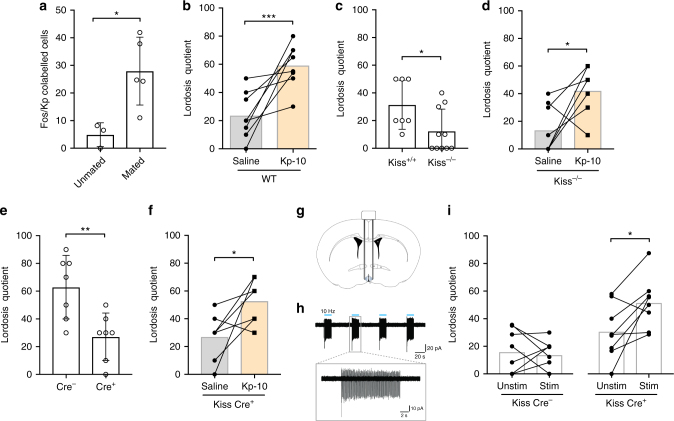Fig. 2.
RP3V kisspeptin neurons are an important component of the neural network regulating lordosis behavior. a Mating specifically activated kisspeptin neurons in the RP3V of ovary intact female mice as determined by the percentage of Fos/Kp co-labeled cells. *P ≤ 0.05; unpaired t test; n = 3/5. b A peripheral injection of kisspeptin-10 (Kp-10) at a dose of 0.52 µg kg−1 stimulated lordosis behavior. ***P ≤ 0.001; paired t test; n = 8 per group. c Lordosis behavior is attenuated in kisspeptin knockout (Kiss−/−) mice. Please note that the background strain of Kiss+/+ and Kiss−/− mice is 129SvJ, which showed overall lower levels of lordosis behavior compared to C57Bl/6J mice. *P ≤ 0.05; Mann–Whitney U test; n = 7/10. d A peripheral injection with Kp-10-induced lordosis behavior in Kiss−/− females. *P ≤ 0.05; paired t test; n = 9. e–f Stereotaxic injection with an AAV encoding a Cre-dependent caspase bilaterally into the RP3V decreased lordosis behavior, but was restored by a peripheral Kp-10 injection. e**P ≤ 0.01; unpaired t test; *P ≤ 0.05. f Paired t test; n = 7 per group. g Anatomical drawing showing the position of the bilateral cannula holding optical fibers with 45° oriented mirrors tip into the RP3V. h Blue light photostimulation (10 Hz, 473 nm) elicited robust firing of kisspeptin neurons in KissIC mice brain slices, which were injected with an AAV encoding a Cre-dependent channelrhodopsin (AAV-ChR2) bilaterally into the RP3V. i Blue light photostimulation (Stim) increased the expression of lordosis behavior in KissIC mice, which were injected with AAV-ChR2 bilaterally into the RP3V. *P ≤ 0.05, paired t test; n = 8 per group (Kiss Cre− and Kiss Cre+). Bars represent the mean ± SEM. For all experimental details, see Supplementary Table 1

